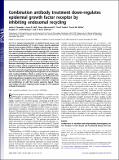| dc.contributor.author | Spangler, Jamie Berta | |
| dc.contributor.author | Neil, Jason Robert | |
| dc.contributor.author | Abramovitch, Sivan | |
| dc.contributor.author | Yarden, Yosef | |
| dc.contributor.author | White, Forest M. | |
| dc.contributor.author | Lauffenburger, Douglas A. | |
| dc.contributor.author | Wittrup, Karl Dane | |
| dc.date.accessioned | 2011-11-01T18:14:22Z | |
| dc.date.available | 2011-11-01T18:14:22Z | |
| dc.date.issued | 2010-07 | |
| dc.date.submitted | 2009-11 | |
| dc.identifier.issn | 1091-6490 | |
| dc.identifier.uri | http://hdl.handle.net/1721.1/66709 | |
| dc.description.abstract | Due to its common dysregulation in epithelial-based cancers and extensive characterization of its role in tumor growth, epidermal growth factor receptor (EGFR) is a highly validated target for anticancer therapies. There has been particular interest in the development of monoclonal antibodies (mAbs) targeting EGFR, resulting in two approved mAb-based drugs and several others in clinical trials. It has recently been reported that treatment with combinations of noncompetitive mAbs can induce receptor clustering, leading to synergistic receptor down-regulation. We elucidate three key aspects of this phenomenon. First, we show that highly potent combinations consisting of two noncompetitive mAbs that target EGFR domain 3 reduce surface receptor levels by up to 80% with a halftime of 0.5–5 h in both normal and transformed human cell lines to an extent inversely proportional to receptor density. Second, we find the mechanism underlying down-regulation to be consistent with recycling inhibition. Third, in contrast to the agonism associated with ligand-induced down-regulation, we demonstrate that mAb-induced down-regulation does not activate EGFR or its downstream effectors and it leads to synergistic reduction in migration and proliferation of cells that secrete autocrine ligand. These new insights will aid in ongoing rational design of EGFR-targeted antibody therapeutics. | en_US |
| dc.description.sponsorship | National Institutes of Health (U.S.) (Grant CA96504) | en_US |
| dc.description.sponsorship | National Defense Science and Engineering Graduate Fellowship | en_US |
| dc.language.iso | en_US | |
| dc.publisher | National Academy of Sciences (U.S.) | en_US |
| dc.relation.isversionof | http://dx.doi.org/10.1073/pnas.0913476107 | en_US |
| dc.rights | Article is made available in accordance with the publisher's policy and may be subject to US copyright law. Please refer to the publisher's site for terms of use. | en_US |
| dc.source | PNAS | en_US |
| dc.title | Combination antibody treatment down-regulates epidermal growth factor receptor by inhibiting endosomal recycling | en_US |
| dc.type | Article | en_US |
| dc.identifier.citation | Spangler, J. B. et al. “Combination antibody treatment down-regulates epidermal growth factor receptor by inhibiting endosomal recycling.” Proceedings of the National Academy of Sciences 107 (2010): 13252-13257. ©2010 by the National Academy of Sciences. | en_US |
| dc.contributor.department | Massachusetts Institute of Technology. Department of Biological Engineering | en_US |
| dc.contributor.department | Massachusetts Institute of Technology. Department of Chemical Engineering | en_US |
| dc.contributor.approver | White, Forest M. | |
| dc.contributor.mitauthor | White, Forest M. | |
| dc.contributor.mitauthor | Spangler, Jamie Berta | |
| dc.contributor.mitauthor | Neil, Jason Robert | |
| dc.contributor.mitauthor | Wittrup, Karl Dane | |
| dc.relation.journal | Proceedings of the National Academy of Sciences of the United States of America | en_US |
| dc.eprint.version | Final published version | en_US |
| dc.type.uri | http://purl.org/eprint/type/JournalArticle | en_US |
| eprint.status | http://purl.org/eprint/status/PeerReviewed | en_US |
| dspace.orderedauthors | Spangler, J. B.; Neil, J. R.; Abramovitch, S.; Yarden, Y.; White, F. M.; Lauffenburger, D. A.; Wittrup, K. D. | en |
| dc.identifier.orcid | https://orcid.org/0000-0002-1545-1651 | |
| dc.identifier.orcid | https://orcid.org/0000-0003-2398-5896 | |
| mit.license | PUBLISHER_POLICY | en_US |
| mit.metadata.status | Complete | |
